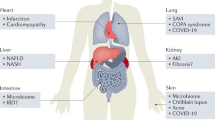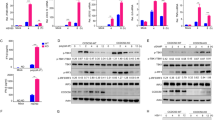Abstract
The enzyme cyclic GMP-AMP synthase (cGAS) is essential for detecting aberrantly located double-stranded DNA (dsDNA) from genomic, mitochondrial, and microbial origins. Through the synthesis of 2′3′-cGAMP, cGAS triggers the activation of the stimulator of interferon genes pathway, which initiates in vivo innate immune responses. Here, we identify zinc finger proteins ZNF593, which translocate from the nucleus to the cytoplasm after viral infection, as a negative regulator of antiviral type I IFN (IFN-I) production. ZNF593 directly binds to cGAS and suppresses its activation by inhibiting the cGAS-dsDNA interaction. ZNF593 deficiency increases IRF3 nuclear translocation and promotes DNA virus-triggered IFN production. Furthermore, ZNF593 deficiency promotes antiviral innate responses in vivo, improving survival rates in mice against HSV-1 infection. We further find that ZNF593 plays a protective role in systemic lupus erythematosus (SLE) pathology. Notably, replenishing ZNF593 effectively reduced IFN production in peripheral blood mononuclear cells (PBMCs) of SLE patients or in the TMPD-induced murine SLE model. Our findings suggest that ZNF593 negatively regulates IFN-β signaling by targeting cGAS activation, providing new insights into the regulatory mechanisms for antiviral defenses and autoimmune diseases.
This is a preview of subscription content, access via your institution
Access options
Subscribe to this journal
Receive 12 print issues and online access
$259.00 per year
only $21.58 per issue
Buy this article
- Purchase on SpringerLink
- Instant access to full article PDF
Prices may be subject to local taxes which are calculated during checkout







Similar content being viewed by others
Data availability
All relevant data that support the study are provided in the article and Supplementary Information. Other relevant data can be obtained from the corresponding author upon reasonable request. Source data are provided with this paper.
References
Zhang ZD, Zhong B. Regulation and function of the cGAS-MITA/STING axis in health and disease. Cell Insight. 2022;1:100001.
Wu J, Sun L, Chen X, Du F, Shi H, Chen C, et al. Cyclic GMP-AMP is an endogenous second messenger in innate immune signaling by cytosolic DNA. Science. 2013;339:826–30.
Sun L, Wu J, Du F, Chen X, Chen ZJ. Cyclic GMP-AMP synthase is a cytosolic DNA sensor that activates the type I interferon pathway. Science. 2013;339:786–91.
Ablasser A, Goldeck M, Cavlar T, Deimling T, Witte G, Rohl I, et al. cGAS produces a 2’-5’-linked cyclic dinucleotide second messenger that activates STING. Nature. 2013;498:380–4.
Diner EJ, Burdette DL, Wilson SC, Monroe KM, Kellenberger CA, Hyodo M, et al. The innate immune DNA sensor cGAS produces a noncanonical cyclic dinucleotide that activates human STING. Cell Rep. 2013;3:1355–61.
Hu MM, Yang Q, Xie XQ, Liao CY, Lin H, Liu TT, et al. Sumoylation promotes the stability of the DNA sensor cGAS and the adaptor STING to regulate the kinetics of response to DNA Virus. Immunity. 2016;45:555–69.
Chen Q, Sun L, Chen ZJ. Regulation and function of the cGAS-STING pathway of cytosolic DNA sensing. Nat Immunol. 2016;17:1142–9.
Civril F, Deimling T, de Oliveira Mann CC, Ablasser A, Moldt M, Witte G, et al. Structural mechanism of cytosolic DNA sensing by cGAS. Nature. 2013;498:332–7.
Zhang X, Bai XC, Chen ZJ. Structures and mechanisms in the cGAS-STING innate immunity pathway. Immunity. 2020;53:43–53.
Dai J, Huang YJ, He X, Zhao M, Wang X, Liu ZS, et al. Acetylation blocks cGAS activity and inhibits Self-DNA-induced autoimmunity. Cell. 2019;176:1447–60.e14.
Liu ZS, Cai H, Xue W, Wang M, Xia T, Li WJ, et al. G3BP1 promotes DNA binding and activation of cGAS. Nat Immunol. 2019;20:18–28.
Gao D, Li T, Li XD, Chen X, Li QZ, Wight-Carter M, et al. Activation of cyclic GMP-AMP synthase by self-DNA causes autoimmune diseases. Proc Natl Acad Sci USA. 2015;112:E5699–705.
Hopfner KP, Hornung V. Molecular mechanisms and cellular functions of cGAS-STING signalling. Nat Rev Mol Cell Biol. 2020;21:501–21.
Pan M, Yin Y, Hu T, Wang X, Jia T, Sun J, et al. UXT attenuates the CGAS-STING1 signaling by targeting STING1 for autophagic degradation. Autophagy. 2023;19:440–56.
Motwani M, Pesiridis S, Fitzgerald KA. DNA sensing by the cGAS-STING pathway in health and disease. Nat Rev Genet. 2019;20:657–74.
Vilas CK, Emery LE, Denchi EL, Miller KM. Caught with One’s Zinc fingers in the genome integrity cookie jar. Trends Genet. 2018;34:313–25.
Cassandri M, Smirnov A, Novelli F, Pitolli C, Agostini M, Malewicz M, et al. Zinc-finger proteins in health and disease. Cell Death Discov. 2017;3:17071.
Qi YY, Cui Y, Lang H, Zhai YL, Zhang XX, Wang XY, et al. The ZNF76 rs10947540 polymorphism associated with systemic lupus erythematosus risk in Chinese populations. Sci Rep. 2021;11:5186.
Petukhova L, Duvic M, Hordinsky M, Norris D, Price V, Shimomura Y, et al. Genome-wide association study in alopecia areata implicates both innate and adaptive immunity. Nature. 2010;466:113–7.
Xie G, Lu Y, Sun Y, Zhang SS, Keystone EC, Gregersen PK, et al. Identification of the NF-kappaB activating protein-like locus as a risk locus for rheumatoid arthritis. Ann Rheum Dis. 2013;72:1249–54.
Kasinathan, B., Colmenares S.U., 3rd, McConnell H., Young J.M., Karpen G.H., and Malik H.S., Innovation of heterochromatin functions drives rapid evolution of essential ZAD-ZNF genes in Drosophila. Elife, 2020;9:e63368.
Hatakeyama S. TRIM family proteins: roles in autophagy, immunity, and carcinogenesis. Trends Biochem Sci. 2017;42:297–311.
Sakata J, Utsumi F, Suzuki S, Niimi K, Yamamoto E, Shibata K, et al. Inhibition of ZEB1 leads to inversion of metastatic characteristics and restoration of paclitaxel sensitivity of chronic chemoresistant ovarian carcinoma cells. Oncotarget. 2017;8:99482–94.
Shin JH, Ko HS, Kang H, Lee Y, Lee YI, Pletinkova O, et al. PARIS (ZNF746) repression of PGC-1alpha contributes to neurodegeneration in Parkinson’s disease. Cell. 2011;144:689–702.
Jo, A., Lee Y., Kam T.I., Kang S.U., Neifert S., Karuppagounder S.S., et al., PARIS farnesylation prevents neurodegeneration in models of Parkinson’s disease. Sci Transl Med, 2021;13:eaax8891.
Fehr AR, Singh SA, Kerr CM, Mukai S, Higashi H, Aikawa M. The impact of PARPs and ADP-ribosylation on inflammation and host-pathogen interactions. Genes Dev. 2020;34:341–59.
Lian H, Zang R, Wei J, Ye W, Hu MM, Chen YD, et al. The zinc-finger protein ZCCHC3 binds RNA and facilitates viral RNA Sensing and Activation of the RIG-I-like Receptors. Immunity. 2018;49:438–48.e5.
Mullard A. First in vivo gene-editing drugs enter the clinic. Nat Rev Drug Discov. 2017;17:7.
Wang, G. and Zheng C., Zinc finger proteins in the host-virus interplay: multifaceted functions based on their nucleic acid-binding property. FEMS Microbiol Rev. 2021;45:1–11.
Hayakawa S, Shiratori S, Yamato H, Kameyama T, Kitatsuji C, Kashigi F, et al. ZAPS is a potent stimulator of signaling mediated by the RNA helicase RIG-I during antiviral responses. Nat Immunol. 2011;12:37–44.
Luqman-Fatah A, Watanabe Y, Uno K, Ishikawa F, Moran JV, Miyoshi T. The interferon stimulated gene-encoded protein HELZ2 inhibits human LINE-1 retrotransposition and LINE-1 RNA-mediated type I interferon induction. Nat Commun. 2023;14:203.
Fusco DN, Pratt H, Kandilas S, Cheon SS, Lin W, Cronkite DA, et al. HELZ2 Is an IFN effector mediating suppression of dengue virus. Front Microbiol. 2017;8:240.
Liu S, Cai X, Wu J, Cong Q, Chen X, Li T, et al. Phosphorylation of innate immune adaptor proteins MAVS, STING, and TRIF induces IRF3 activation. Science. 2015;347:aaa2630.
Terunuma A, Shiba K, Noda T. A novel genetic system to isolate a dominant negative effector on DNA-binding activity of Oct-2. Nucleic Acids Res. 1997;25:1984–90.
Bengtsson AA, Ronnblom L. Role of interferons in SLE. Best Pract Res Clin Rheumatol. 2017;31:415–28.
Zheng X, Xiao J, Jiang Q, Zheng L, Liu C, Dong C, et al. AKT2 reduces IFNbeta1 production to modulate antiviral responses and systemic lupus erythematosus. EMBO J. 2022;41:e108016.
An J, Durcan L, Karr RM, Briggs TA, Rice GI, Teal TH, et al. Expression of Cyclic GMP-AMP Synthase in Patients With Systemic Lupus Erythematosus. Arthritis Rheumatol. 2017;69:800–7.
Baechler EC, Batliwalla FM, Karypis G, Gaffney PM, Ortmann WA, Espe KJ, et al. Interferon-inducible gene expression signature in peripheral blood cells of patients with severe lupus. Proc Natl Acad Sci USA. 2003;100:2610–5.
Crow YJ, Manel N. Aicardi-Goutieres syndrome and the type I interferonopathies. Nat Rev Immunol. 2015;15:429–40.
Kiriakidou M, Ching CL. Systemic lupus erythematosus. Ann Intern Med. 2020;172:ITC81–I96.
Furie R, Khamashta M, Merrill JT, Werth VP, Kalunian K, Brohawn P, et al. Anifrolumab, an anti-interferon-alpha receptor monoclonal antibody, in moderate-to-severe systemic lupus erythematosus. Arthritis Rheumatol. 2017;69:376–86.
Tian M, Liu W, Zhang Q, Huang Y, Li W, Wang W, et al. MYSM1 represses innate immunity and autoimmunity through suppressing the cGAS-STING pathway. Cell Rep. 2020;33:108297.
Hayes PL, Lytle BL, Volkman BF, Peterson FC. The solution structure of ZNF593 from Homo sapiens reveals a zinc finger in a predominantly unstructured protein. Protein Sci. 2008;17:571–6.
Vaquerizas JM, Kummerfeld SK, Teichmann SA, Luscombe NM. A census of human transcription factors: function, expression and evolution. Nat Rev Genet. 2009;10:252–63.
Bassler J, Klein I, Schmidt C, Kallas M, Thomson E, Wagner MA, et al. The conserved Bud20 zinc finger protein is a new component of the ribosomal 60S subunit export machinery. Mol Cell Biol. 2012;32:4898–912.
Bai X, Sui C, Liu F, Chen T, Zhang L, Zheng Y, et al. The protein arginine methyltransferase PRMT9 attenuates MAVS activation through arginine methylation. Nat Commun. 2022;13:5016.
Liu H, Yan Z, Zhu D, Xu H, Liu F, Chen T, et al. CD-NTase family member MB21D2 promotes cGAS-mediated antiviral and antitumor immunity. Cell Death Differ. 2023;30:992–1004.
Acknowledgements
We thank Dr. Deyu Zhu (Shandong University, China) for kindly providing Human cGAS purified protein. This work was supported by the grants from the National key research and development program (2024YFA0918401 to BL), the National Natural Science Foundation of China (82222027, 32270918 to BL, 82301984 to XB, 82321002, 32230033, 81930039 to CG), grants from the National key research and development program (2021YFC2300603 to CG), grants from Natural Science Foundation of Shandong Province (ZR201911140289 to CG), the China Postdoctoral Science Foundation (2024M751821 to XB), and Shandong Postdoctora1 Science Foundation (SDCX-ZG-202400006 to XB).
Author information
Authors and Affiliations
Contributions
CG and BL conceived the study; CG and BL designed and supervised the research; XB performed the research; ND, NC, MZ, JY, YZ, YL, JZ contributed reagents and experimental advice; TC, FL, WS, YZ, WZ, QS provided discussions; CG, BL and XB analyzed the data and wrote the paper.
Corresponding authors
Ethics declarations
Competing interests
The authors declare no competing interest.
Additional information
Publisher’s note Springer Nature remains neutral with regard to jurisdictional claims in published maps and institutional affiliations.
Rights and permissions
Springer Nature or its licensor (e.g. a society or other partner) holds exclusive rights to this article under a publishing agreement with the author(s) or other rightsholder(s); author self-archiving of the accepted manuscript version of this article is solely governed by the terms of such publishing agreement and applicable law.
About this article
Cite this article
Bai, X., Dong, N., Cao, N. et al. ZNF593 regulates the cGAS-mediated innate immune response by attenuating cGAS-DNA binding. Cell Death Differ 32, 1845–1858 (2025). https://doi.org/10.1038/s41418-025-01508-5
Received:
Revised:
Accepted:
Published:
Issue date:
DOI: https://doi.org/10.1038/s41418-025-01508-5



